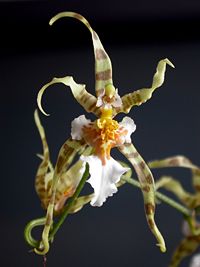Phymatochilum: Difference between revisions
imported>Dalton Holland Baptista No edit summary |
imported>Dalton Holland Baptista No edit summary |
||
| Line 27: | Line 27: | ||
==Distribution and habit== | ==Distribution and habit== | ||
''Phymatochilum brasiliense'' is a comparatively large epiphytic species which inhabits high areas of the [[Atlantic Forest]] of [[Rio de Janeiro State|Rio de Janeiro]], [[São Paulo State|São Paulo]], [[Espírito Santo]] and [[Pernambuco]] States of Brazil,<ref name="OB"><span style="font-variant:small-caps">Pabst, Guido & Dungs, Fritz </span>: '''Orchidaceae Brasilienses vol. 2''' p. 195. Brucke-Verlag Kurt Schmersow, Hildesheim, 1978. ISBN 3871050107 </ref> particularly in the warmer areas around [[Serra do Mar]] chain of mountains, where it is somewhat rare. It grows under the shadow of [[tree]]s, however, mostly near the jungles well ventilated clearances where it can get brighter light, between 600 and 1,300 meters of [[altitude]] in dryer areas. It ordinarily grows over the trees where the shade is not intense, on thick branches.<ref><span style="font-variant:small-caps">Baker, Charles O & Baker, Margaret L.</span> (2006), ''Miltonia phymatochila'' in '''Orchid Species Culture''' Oncidium/Odontoglossum Alliance: 345, Timber Press. ISBN 9780881927757 </ref> | |||
<!-- | <!-- | ||
Em 2001, com base em resultados de análises filogenéticas o gênero recebeu o acréscimo de mais uma espécie, previamente classificada como Oncidium phymatochilum , a ser classificada como Miltonia phymatochila. Espécie de morfologia por demais divergente das outras Miltonia , esta proposta não encontrou eco entre muitos taxonomistas. Em 2005 Eric Christenson propôs um novo gênero uniespecífico para ela, que seria então denominada Phymatochilum brasiliense . | |||
O Phymatochilum brasiliense não guarda praticamente nenhuma semelhança com as outras espécies subordinadas a este gênero. Apresenta pseudobulbos e folhas muito mais robustos. O rizoma é bastante curto e os pseudobulbos agregados, ovóides, curtos, lateralmente comprimidos, mas muito carnosos e fibrosos, arredondados, de cor muito mais escura, com matizes amarronzados, monofoliados, com folha larga, coriácea e bastante grande, no aspecto geral lembrando muito a vegetação da Maxillaria setigera. A inflorescência é paniculada, muito mais alta que as folhas, com mais de uma centena de pequenas flores espaçadas que a primeira vista lembram Oncidium, com sépalas e pétalas eretas e bem explanadas, onduladas, e longamente acuminadas. | |||
slightly compressed, enveloped basally by several imbricating sheaths and carrying a single apical, elliptic to elliptic-oblanceolate, coriaceous, acute or obtuse, dark green, speckled red basally leaf and blooms on a pendant, 3 to 6' [90 to 180 cm] long, loosely many flowered, panicle that is pale green with crimson spots and has showy, light, sweet fragrance flowers with highly variable lateral sepals and occurring in the early fall. | |||
--> | --> | ||
==Description== | ==Description== | ||
| Line 52: | Line 58: | ||
|- | |- | ||
| Inflorescence | | Inflorescence | ||
| | | 1800 | ||
| | | - | ||
|- | |- | ||
| Flower | | Flower | ||
| Line 68: | Line 74: | ||
|- | |- | ||
| Labellum | | Labellum | ||
| | | 18 | ||
| 12 | | 12 | ||
|} | |} | ||
Revision as of 16:11, 18 March 2009
| Phymatochilum | ||||||||||||||||||||
|---|---|---|---|---|---|---|---|---|---|---|---|---|---|---|---|---|---|---|---|---|
 | ||||||||||||||||||||
| Scientific classification | ||||||||||||||||||||
| ||||||||||||||||||||
| Type species | ||||||||||||||||||||
| Oncidium phymatochilum Lindl. 1848 | ||||||||||||||||||||
| Species | ||||||||||||||||||||
| ||||||||||||||||||||
| Synonyms | ||||||||||||||||||||
|
Phymatochilum is an orchid genus formed by only one species, Phymatochilum brasiliense, inhabitant of Serra do Mar mountains in Brazilian southeast and northeast, which vegetatively resembles Oncidium species, however, is more closely related to the genus Miltonia.
Distribution and habit
Phymatochilum brasiliense is a comparatively large epiphytic species which inhabits high areas of the Atlantic Forest of Rio de Janeiro, São Paulo, Espírito Santo and Pernambuco States of Brazil,[1] particularly in the warmer areas around Serra do Mar chain of mountains, where it is somewhat rare. It grows under the shadow of trees, however, mostly near the jungles well ventilated clearances where it can get brighter light, between 600 and 1,300 meters of altitude in dryer areas. It ordinarily grows over the trees where the shade is not intense, on thick branches.[2]
Description
| Measures (mm) | ||
| Structure | Lenght | Width |
| Rhizome | 15 | 15 |
| Leaf | 500 | 100 |
| Pseudobulb | 100 | 70 |
| Inflorescence | 1800 | - |
| Flower | 50 | 25 |
| Sepal | 35 | 3 |
| Petal | 25 | 3 |
| Labellum | 18 | 12 |
Taxonomic notes
References
- ↑ Pabst, Guido & Dungs, Fritz : Orchidaceae Brasilienses vol. 2 p. 195. Brucke-Verlag Kurt Schmersow, Hildesheim, 1978. ISBN 3871050107
- ↑ Baker, Charles O & Baker, Margaret L. (2006), Miltonia phymatochila in Orchid Species Culture Oncidium/Odontoglossum Alliance: 345, Timber Press. ISBN 9780881927757